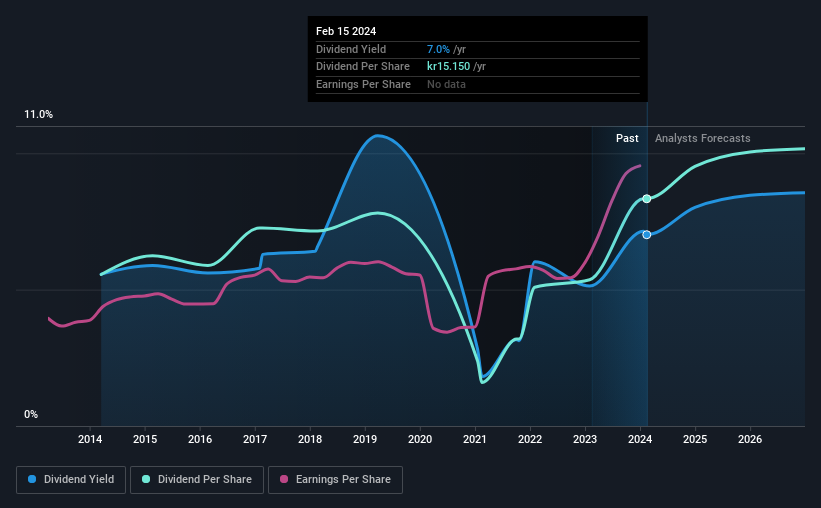
Swedbank AB (publ) (STO:SWED A) has announced that it will be increasing its dividend from last year's comparable payment on the 4th of April to SEK15.15. This takes the dividend yield to 7.0%, which shareholders will be pleased with.
Check out our latest analysis for Swedbank
Swedbank's Dividend Forecasted To Be Well Covered By Earnings
While it is great to have a strong dividend yield, we should also consider whether the payment is sustainable.
Having distributed dividends for at least 10 years, Swedbank has a long history of paying out a part of its earnings to shareholders. Past distributions do not necessarily guarantee future ones, but Swedbank's payout ratio of 50% is a good sign as this means that earnings decently cover dividends.
Over the next 3 years, EPS is forecast to fall by 12.0%. Fortunately, analysts forecast the future payout ratio to be 70% over the same time horizon, which is in the range that makes us comfortable with the sustainability of the dividend.

Dividend Volatility
Although the company has a long dividend history, it has been cut at least once in the last 10 years. Since 2014, the dividend has gone from SEK10.10 total annually to SEK15.15. This works out to be a compound annual growth rate (CAGR) of approximately 4.1% a year over that time. It's encouraging to see some dividend growth, but the dividend has been cut at least once, and the size of the cut would eliminate most of the growth anyway, which makes this less attractive as an income investment.
The Dividend Has Growth Potential
With a relatively unstable dividend, it's even more important to evaluate if earnings per share is growing, which could point to a growing dividend in the future. Swedbank has seen EPS rising for the last five years, at 9.9% per annum. Since earnings per share is growing at an acceptable rate, and the payout policy is balanced, we think the company is positioning itself well to grow earnings and dividends in the future.
Swedbank Looks Like A Great Dividend Stock
Overall, a dividend increase is always good, and we think that Swedbank is a strong income stock thanks to its track record and growing earnings. The earnings easily cover the company's distributions, and the company is generating plenty of cash. However, it is worth noting that the earnings are expected to fall over the next year, which may not change the long term outlook, but could affect the dividend payment in the next 12 months. All in all, this checks a lot of the boxes we look for when choosing an income stock.
Investors generally tend to favour companies with a consistent, stable dividend policy as opposed to those operating an irregular one. Still, investors need to consider a host of other factors, apart from dividend payments, when analysing a company. To that end, Swedbank has 2 warning signs (and 1 which doesn't sit too well with us) we think you should know about. Looking for more high-yielding dividend ideas? Try our collection of strong dividend payers.
New: Manage All Your Stock Portfolios in One Place
We've created the ultimate portfolio companion for stock investors, and it's free.
• Connect an unlimited number of Portfolios and see your total in one currency
• Be alerted to new Warning Signs or Risks via email or mobile
• Track the Fair Value of your stocks
Have feedback on this article? Concerned about the content? Get in touch with us directly. Alternatively, email editorial-team (at) simplywallst.com.
This article by Simply Wall St is general in nature. We provide commentary based on historical data and analyst forecasts only using an unbiased methodology and our articles are not intended to be financial advice. It does not constitute a recommendation to buy or sell any stock, and does not take account of your objectives, or your financial situation. We aim to bring you long-term focused analysis driven by fundamental data. Note that our analysis may not factor in the latest price-sensitive company announcements or qualitative material. Simply Wall St has no position in any stocks mentioned.
About OM:SWED A
Swedbank
Provides various banking products and services to private and corporate customers in Sweden, Estonia, Latvia, Lithuania, Norway, the United States, Finland, Denmark, Luxembourg, and China.
Undervalued established dividend payer.


